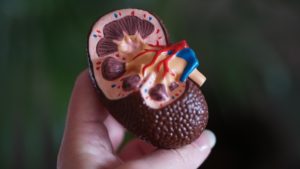
Kidney stones are a common urologic disorder that affects men in greater numbers than women. The initial presentation typically occurs between the third and fifth decade of life.
There are five major types of urinary stones:
- Calcium oxalate
- Calcium phosphate
- Struvite (magnesium ammonium phosphate)
- Uric acid
- Cystine
The most common types of stones are formed with calcium and can be seen on plain x-rays.
Risk factors for developing kidney stones include living in areas of high humidity and elevated temperatures. Sedentary individuals are also at high risk. Intake of high protein and salt in the diet are also contributing factors to stone formation.
Clinical Findings of Kidney Stones
Stones that obstruct usually present with acute and severe colic. The pain usually occurs suddenly and may awaken a patient from sleep. The pain is localized in the flank area and is usually severe, unremitting and may be associated with nausea and vomiting. A distinguishing factor to differentiate between kidney stones and acute abdomen is that patients with stones are constantly moving in order to find a comfortable sport whereas those with an acute abdomen remain as still as possible. The pain can occur episodically and may radiate anteriorly over the abdomen. When the stone progresses down the ureter, the pain may be referred into the ipsilateral groin. If the stone becomes stuck at the ureterovesical junction, patients will complain of marked urinary urgency and frequency, and in men pain at the tip of the penis. Once the stone makes it into the bladder, there is typically minimal pain when it passes through the urethra.
Treatment of Kidney Stones
The greatest treatment of kidney stones is prevention by dietary modification. Recurrence of stone formation is up to 50% without needed modifications. Of greatest importance in reducing stone recurrence is increasing fluid intake. Patients are encouraged to consume fluids during meals, two hours after each meal (when the body is most dehydrated), and before going to sleep in the evening. This should be enough to produce at least one overnight void. Patients should be encouraged to also ingest additional fluids during the night. Increasing fluids only during the day may not dilute supersaturated urine overnight and thus initiate a new stone.
In some cases, surgical removal of the stones may be indicated. Any obstructing stone with an associated infection is a medical emergency that requires prompt drainage by a ureteral catheter or a percutaneous nephrostomy tube.
Kidney Stone Clinical Pearls
- Severe flank pain
- Nausea and vomiting
- Greatest treatment is prevention through dietary changes
- Visible on non-contrast CT or ultrasound
If you liked this tip, be sure to check out our other resources for pre-NP students, NP students, and practicing NPs. Shop our NP clinical products here and remember to join our Facebook group for board review questions!
View comments
+ Leave a comment